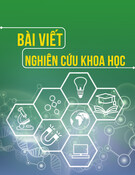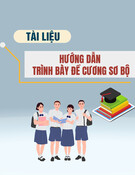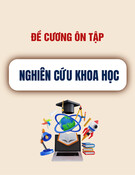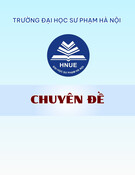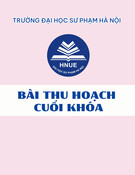
VNU Journal of Science: Education Research, Vol. 41, No. 1 (2025) 48-61
48
Original Article
Factors Affecting Career Choices of Students
in Private High Schools in Ho Chi Minh City
Truong Tan Dat1, Tran Quoc Giang2,*
Dong Thap University, Dong Thap, 783 Pham Huu Lau, Ward 6, Cao Lanh, Dong Thap, Vietnam
Received 05th November 2024
Revised 19th November 2024; Accepted 09th December 2024
Abstract: This article comprehensively examines the factors influencing career decisions of
students in private high schools in Ho Chi Minh City. Using both qualitative and quantitative
research methods, the study reveals that students' career choices are shaped by personal factors,
such as passion, self-assessment abilities, independence, and are strongly influenced by family,
school, and social environment. The family plays a crucial role in providing guidance and financial
support, enabling students to pursue desired career paths. Schools, through career counseling
programs and extracurricular activities, offer opportunities for students to explore and gain a
deeper understanding of the requirements of various professions. The social environment,
especially the influence of media and peers, contributes to shaping career role models and industry
trends. The study also indicates that in a growing economy, students increasingly consider factors
such as salary, employment opportunities, and career growth potential. Consequently, the article
proposes support strategies involving families, schools, and the community to foster sustainable
career orientation for students, aligning with the demands of the modern labor market.
Keywords: Career orientation, influencing factors, private high school, labor market, career counseling.
1. Introduction *
In shaping a career, the career choices of
high school students represent a strategic step
with profound impacts on their lives and future
personal development. This is especially true
for students in private high schools in Ho Chi
Minh City, a dynamic and diverse educational
environment. Here, career decisions require
_______
* Corresponding author.
E-mail address: giang.tq894@gmail.com
https://doi.org/10.25073/2588-1159/vnuer.5228
careful consideration due to the interplay of
influences from family, school, society,
personal factors, and the labor market. In the
context of strong globalization and digital
transformation, career selection goes beyond
traditional fields, expanding into new areas that
demand complex skills and highlight the
flexibility of the workforce [1-3]. Therefore,
understanding the factors affecting students’
career decisions has become an urgent need, not
only to provide better guidance for students but
also to ensure long-term engagement and
growth in their chosen professions [4-6].







